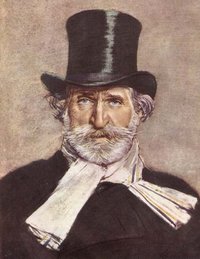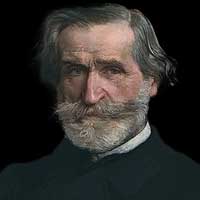Giuseppe Verdi - Biography
Giuseppe Verdi Biography

Giuseppe Fortunino Francesco Verdi (October 10, 1813 – January 27, 1901) was one of the great composers of Italian opera. A composer of romantic music, his work was already very popular during his lifetime and remains so today.
| Contents |
Biography
Born in the Duchy of Parma in Le Roncole, at that time under Napoleon's occupation, he moved to Busseto in 1824 where he started his musical studies with Ferdinando Provesi. Verdi is also known as 'the swan from Busseto'.
He composed an overture for Gioacchino Rossini's Il Barbiere di Siviglia (The Barber of Seville), then he moved to Milan, but he was not accepted at the conservatory, so he had private studies with Vincenzo Lavigna. Marrying his patron's daughter, Verdi became the municipal music director of Busseto after completing his studies.
In 1838, the leading European musical editor Giovanni Ricordi bought his copyrights and this business would last for the rest of his life, passing through the generations of Ricordi's family, with Tito and Giulio Ricordi being considered as part of his family.
After three years as a musical director, he returned to Milan to produce his 1839 opera Oberto, Conte di San Bonifacio which opened in Milan's La Scala on November 17, 1839. This success was modest at best, but it was enough that he was contracted for further operatic works. Un Giorno di Regno which was his only attempt at writing a comedy until Falstaff. Un Giorno di Regno was a decided failure and no wonder, it was written shortly after his first wife and child died. Verdi loved his first wife, Margherita Barezzi, very much and was devastated when she died so tragically young.
In 1842, he achieved his first real success with Nabucco. Upon reading the libretto about the ancient Jews' exile from their homeland, Verdi was impassioned by his own nationalism. The Jews served as a symbol for his yearning for Italy to be freed from oppression and united. After the success of the opera, Verdi's works became a symbol of Italian independence. Nabucco premiered at La Scala theatre, with Giuseppina Strepponi, soprano, in the part of Abigaille. The singer became his mistress for ten years and, long after the death of his first wife, Verdi would marry her.
After the success of I Lombardi alla Prima Crociata (Milan, February 11, 1843), also increased by some aspects of the political situation (see below), Ernani scored a triumph in La Fenice theatre in Venice. The following year, Giovanna d'Arco and Attila would enforce his fame, but Verdi did not find the rendering of his scripts by La Scala sufficient, so he asked Ricordi not to allow any more productions of his opera in Milan; Attila, Alzira and Macbeth were premiered in other Italian towns. I Masnadieri was seen in London.
While Milan was lost and reconquered by the Austrians, Verdi wrote Il Corsaro, La Battaglia di Legnano, and Luisa Miller, and started a Manon Lescaut which he would never finish. After the polemics for his Stiffelio, in 1851 Rigoletto was a triumph in Venice, and in 1853 he had another great success with Il Trovatore (in Rome) but a very sad fiasco for the first soirťes of La Traviata. These three works in particular were loved by the public, but critics condemned the scandalous subjects depicting free love, suicide and rape.
Other famous operas follow in this period: Les VÍpres siciliennes (I Vespri Siciliani) (Paris), Aroldo (a revision of Stiffelio), Simon Boccanegra (La Fenice), and Un Ballo in Maschera (which was censored).
Now wealthy from the success of his works, the composer purchased an estate in Busseto. He then assisted at the birth of the Kingdom of Italy. In 1861, he was elected as Deputy in the first pariliament of the new nation of Italy. La Forza del Destino had its premiere in St. Petersburg in 1862 and Don Carlos was first presented in Paris.
It was in 1872 that Aida was performed at La Scala with great success. It had been composed for the Egyptian Khedive, on the occasion of the inauguration of a new opera house in Cairo, and not for the opening of the Suez Canal as often mentioned.
Some troubles occurred in his relationship with the Ricordi editors, who were suspected of irregularities concerning huge amounts of money. However, a few years later it was Giulio Ricordi who proposed Otello, which had its premiere in 1887. Falstaff would follow after other revisions of older works.
He died of a stroke in 1901 in Milan after the completion of his 'Casa di Riposo', a retirement villa for poor artists. In keeping with his humble origin, Verdi took pride in the engagement of the peasant girl (Artemisa) he fathered when he was already 63 to the Guardia Forestale Ernesto and attended their wedding in Langhirono a few years before his death. His funeral was extremely well attended, and a quarter of a million mourners were present to show their respect to one of the most important figures in Italian music. He was interred next to his wife in the 'Famedio' (Temple of Fame) at the Cimitero Monumentale in Milan. A month later, the bodies of Verdi and his wife were both moved to the Casa di Riposo in Milan. During the procession from the Cimitero to the Casa di Riposo, which was attended by throngs of mourners, Arturo Toscanini conducted a choir which sang Va Pensiero.
Verdi's Nationalism
Verdi's works happened to have some resonances with Italian nationalism (e.g. 'Chorus of the Hebrew Slaves' in Nabucco, also known as Va' Pensiero (lyrics with translation here pensiero (http://www.r-ds.com/opera/verdiana/lyrics.htm#Va,) - MP3: 1 (http://www.r-ds.com/domingo/Soundfiles/vapensiero.mp3)), which still in modern times has repeatedly been proposed as a possible Italian national anthem - obviously, there is no reference to racism).
More curiously, someone discovered that his surname, Verdi, is the acronym of Vittorio Emanuele Re D'Italia (Victor Emmanuel King of Italy), when Milan (still under Austrian occupation) was beginning to consider supporting Victor Emmanuel's effort in Italian reunification, as it afterwards did. Clandestine partisans started therefore plotting to have this King of Sardinia conquer Milan and, due to severe Austrian censorship, this campaign was conventionally called 'Viva VERDI' (Verdi stands for Vittorio Emanuele, Re D'Italia. The phrase means 'Long live Victor Emanuele, king of Italy'). The composer was aware of this use of his name and is supposed to have consented. Other references to political events have been seen in his I Lombardi.
Musical style
The music of Verdi served the audience of the mass public rather than that of the musical elite. Opera as his medium is appropriate as opera was not the interest of that elite crowd. The subjects of his works, Verdi said, should be 'original, interesting...and passionate; passions above them all!' (Kamien 243) His most mature works, except for Falstaff, are serious and end tragically. These fast-paced works deal with emotional extremes and the music emphasizes the dramatic situation.
It is the expression of the melodies given to the singers that represents the key expressive spirit of Verdi's work. He uses duets, trios and quartets along with significant and memorable passages for chorus. As he aged, his works became increasingly unconventional. The division between aria and recitative passages blurred and overall there was a greater continuity in the music. The orchestration became more imaginative, and accompaniments were richer. His final work, the comic Falstaff, presents this with its care-free finale: a fugue declaring 'All the world's a joke!'
List of major works
- Sei romanze (Six Romances), 1838
- Oberto, 1839
- Un giorno di regno, 1840
- Nabucco, 1842
- I Lombardi, 1843
- Ernani, 1844
- I due foscari, 1844
- Macbeth, 1847
- I masnadieri, 1847
- Luisa Miller, 1849
- Rigoletto, 1851
- Il trovatore, 1853
- La traviata, 1853
- Les VÍpres siciliennes, 1855
- Aroldo, 1857
- Simon Boccanegra, 1857
- Un ballo in maschera, 1859
- La forza del destino, 1862
- Don Carlo, 1867
- Aida, 1871
- Requiem Mass, 1874
- Otello, 1887
- Falstaff, 1893
See also
- Giuseppe Verdi Compositions
- Asteroid 3975 Verdi, an asteroid named after him.
Media
- Audio file - Enrico Caruso sings La donna Ť mobile Verdi's Rigoletto (1908)
External links
- Giuseppe Verdi Official Site (http://www.giuseppeverdi.it)
References
- Kamien, Roger. Music : An Appreciation. Mcgraw-Hill College; 3rd edition (August 1, 1997) ISBN 0070365210
This biography is published under the GNU Licence
